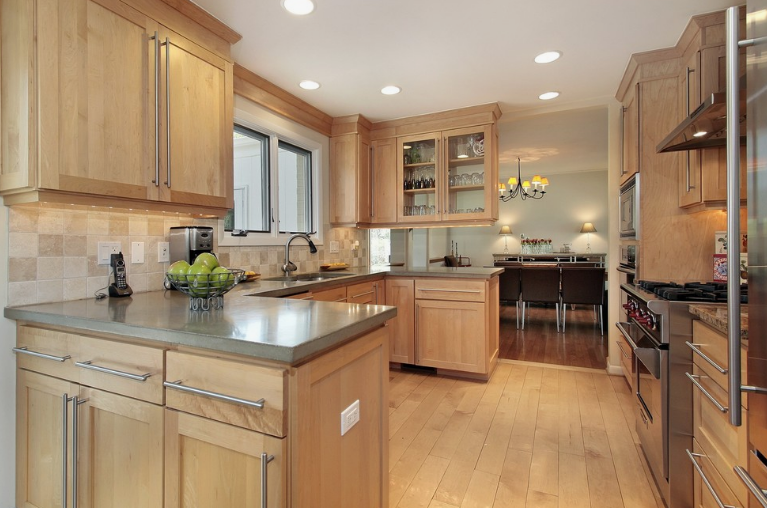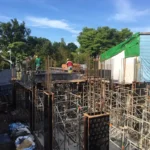When it comes to refreshing your kitchen, you don’t always need a complete overhaul. Sometimes, a small update can make a world of difference, particularly when working with a smaller space. That’s where kitchen refacing comes in. Instead of tearing out cabinets and replacing them entirely, kitchen refacing involves updating the surfaces of your existing cabinetry. It’s an efficient, cost-effective, and less disruptive solution to create a fresh, stylish kitchen—perfect for those looking for a quick and impactful kitchen renovation.
What is Kitchen Refacing?
Kitchen refacing is the process of updating the appearance of your existing cabinets by replacing the doors, drawer fronts, and hardware while keeping the cabinet boxes intact. The surfaces of these boxes are typically covered with a veneer or laminate that matches the look of your new doors. This method can completely change the style of your kitchen, all without the cost and hassle of a full cabinet replacement.
For many homeowners, refacing presents a simpler, less expensive option compared to traditional remodeling. Rather than demolishing your kitchen and starting from scratch, refacing allows you to preserve what’s functional while still getting the modern, refreshed look you desire.
Why Choose Kitchen Refacing for Small Kitchen Updates?
- Cost-Effective Remodeling Solution
Renovating a kitchen can be a major investment. Between cabinetry, countertops, appliances, and labor costs, a full remodel can easily cost tens of thousands of dollars. Kitchen refacing provides an excellent way to update your kitchen for a fraction of the price.
Instead of purchasing all-new cabinets, refacing allows you to give your current ones a whole new look—saving you up to 50% of the cost of replacement cabinets. For small kitchens, this can result in significant savings, letting you focus your budget on other aspects of your kitchen update, such as countertops or lighting.
- Minimal Disruption
One of the biggest advantages of kitchen refacing over a full renovation is the minimal disruption to your daily life. Replacing cabinets involves not just new installations but also knocking down walls, disposing of old materials, and rebuilding from scratch—all of which can take weeks or months. During this time, your kitchen is essentially unusable.
Kitchen refacing, on the other hand, is a much quicker and less invasive process. Professionals can usually complete the project in just a few days, meaning you can continue using your kitchen with only minimal interruption. For those with smaller kitchens, which often function as high-traffic areas in the home, this fast turnaround is a huge plus.
- Increase the Aesthetic Appeal
Whether you have dated, worn-out cabinets or just want a style refresh, kitchen refacing allows you to choose a modern look without the complexity of installing all-new cabinetry. When selecting your new doors and drawer fronts, you’ll have access to a wide variety of finishes, colors, and styles. Whether you’re craving a sleek modern look, a warm traditional feel, or even a bold contemporary aesthetic, there are plenty of options available.
Some of the popular materials used for cabinet refacing include wood veneers, laminate, and thermofoil. You can customize your kitchen to complement the rest of your home’s design theme, creating a cohesive look that adds value to your property. Consider high-quality wood veneer if you want something that exudes warmth and elegance, or opt for a chic modern laminate design if you prefer a contemporary vibe.
- Sustainability
Another significant benefit of kitchen refacing is that it is eco-friendly. Rather than tearing out your current cabinetry and contributing to landfill waste, refacing allows you to reuse and repurpose the existing cabinet boxes. By replacing only the visible portions—the doors and drawer fronts—you avoid sending perfectly good materials to the dump.
Moreover, opting for quality cabinets and more sustainable materials such as eco-friendly laminate finishes or wood veneers can further reduce your environmental footprint. If sustainability is a priority for you, refacing is an ideal choice for your kitchen upgrade.
- Greater Value for Smaller Kitchens
Small kitchens pose unique challenges when it comes to remodelling. Typically, the space constraints mean you have fewer options for structural changes. What you can do, however, is change the finishes, the cabinetry layout, and the details to enhance the existing layout without gutting the entire room.
Refacing is especially advantageous for smaller kitchens because it focuses on aesthetic improvements. If your current cabinetry is still functional but simply looks outdated, refacing can breathe new life into the space with minimal alterations to the existing configuration. Plus, because the cost of kitchen refacing is much lower than full cabinet replacement, it makes sense for small kitchens where more drastic changes may not be feasible.
- Improved Functionality with Customization
When you’re working with a small kitchen, ensuring that every inch of space is used efficiently is crucial. Many homeowners choose kitchen refacing as an opportunity to improve both the appearance and functionality of their cabinets. During the refacing process, new features such as pull-out shelves, lazy Susans, or drawer dividers can be added to maximize storage.
When refacing cabinets, you also have the option to improve the layout of your kitchen. Perhaps you could replace traditional cabinet doors with more modern options like glass-front doors to make the space feel more open, or incorporate deeper cabinets to accommodate more cooking tools. These enhancements allow you to get the most out of your kitchen’s design, even if you can’t make significant physical changes to the space itself.
- Quick Updates for Renters and Home Sellers
For renters or those looking to sell their home, kitchen refacing offers a way to upgrade a kitchen with minimal investment. If you’re getting ready to move or just need a quick facelift to increase your property’s appeal, refacing cabinets can provide you with an affordable way to make the kitchen look brand new.
For landlords, refacing offers a cost-effective method to update apartments or rental properties without doing extensive renovations. For those selling their home, refacing can improve the appeal of your kitchen to potential buyers without going over budget.
How Kitchen Refacing Works
While the process may sound simple, kitchen refacing should be completed by a skilled professional to ensure a smooth and successful outcome. Here’s an overview of what you can expect:
- Assessment: A kitchen designer will assess your cabinets to determine if they’re good candidates for refacing. Your cabinet boxes need to be in good shape to allow the new veneers or laminates to adhere properly.
- Selection: You will work with the designer to select the materials for the new doors and drawer fronts, which will match your preferred style.
- Preparation: The professional team will remove the old doors and drawer fronts and prepare the cabinet boxes by cleaning and sanding them, if needed.
- Application: The new veneers or laminates are applied to the cabinet boxes, and custom-made doors and drawer fronts are fitted. Hardware such as knobs and handles will be installed.
- Final Inspection: Once completed, a quality control check is performed to ensure everything fits perfectly and looks great.
Conclusion
Kitchen refacing is an excellent option for homeowners looking for an affordable, quick, and effective way to update a small kitchen. Whether you’re aiming to create a modern, sleek design or just want a brighter, more welcoming space, kitchen refacing is a hassle-free solution. Best of all, it makes the most of your existing cabinets, helping to preserve your budget while delivering stylish, functional results.
With options for customization and materials that match your unique style preferences, refacing gives your kitchen the makeover it deserves. If you want to improve the look of your small kitchen without blowing your budget, consider kitchen refacing—and watch as your kitchen transforms.
Frequently Asked Questions
- How long does kitchen refacing take? Kitchen refacing typically takes around 3-5 days, depending on the size of your kitchen and the complexity of the project. Since no structural changes are being made, the process is quicker compared to a full remodel.
- Is kitchen refacing suitable for all kitchens? While refacing works well for most kitchens, it’s most effective when the current cabinets are in good structural condition. If the cabinets are falling apart or need substantial repairs, a replacement may be the better option.
- Can I add more storage while refacing my kitchen cabinets? Absolutely! During a kitchen refacing project, you can incorporate additional storage features like pull-out trays, lazy Susans, and more. This gives you the chance to optimize your kitchen’s storage, especially in smaller spaces.


